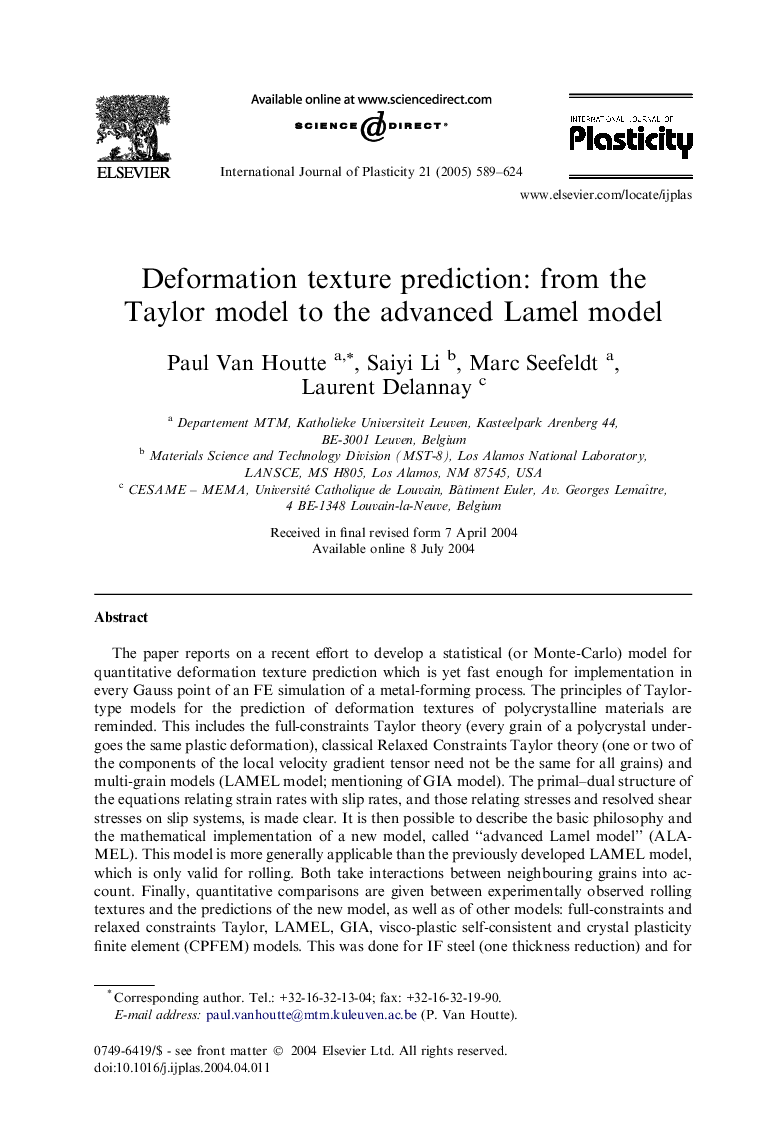| کد مقاله | کد نشریه | سال انتشار | مقاله انگلیسی | نسخه تمام متن |
|---|---|---|---|---|
| 9707247 | 1465724 | 2005 | 36 صفحه PDF | دانلود رایگان |
عنوان انگلیسی مقاله ISI
Deformation texture prediction: from the Taylor model to the advanced Lamel model
دانلود مقاله + سفارش ترجمه
دانلود مقاله ISI انگلیسی
رایگان برای ایرانیان
کلمات کلیدی
موضوعات مرتبط
مهندسی و علوم پایه
سایر رشته های مهندسی
مهندسی مکانیک
پیش نمایش صفحه اول مقاله

چکیده انگلیسی
The paper reports on a recent effort to develop a statistical (or Monte-Carlo) model for quantitative deformation texture prediction which is yet fast enough for implementation in every Gauss point of an FE simulation of a metal-forming process. The principles of Taylor-type models for the prediction of deformation textures of polycrystalline materials are reminded. This includes the full-constraints Taylor theory (every grain of a polycrystal undergoes the same plastic deformation), classical Relaxed Constraints Taylor theory (one or two of the components of the local velocity gradient tensor need not be the same for all grains) and multi-grain models (LAMEL model; mentioning of GIA model). The primal-dual structure of the equations relating strain rates with slip rates, and those relating stresses and resolved shear stresses on slip systems, is made clear. It is then possible to describe the basic philosophy and the mathematical implementation of a new model, called “advanced Lamel model” (ALAMEL). This model is more generally applicable than the previously developed LAMEL model, which is only valid for rolling. Both take interactions between neighbouring grains into account. Finally, quantitative comparisons are given between experimentally observed rolling textures and the predictions of the new model, as well as of other models: full-constraints and relaxed constraints Taylor, LAMEL, GIA, visco-plastic self-consistent and crystal plasticity finite element (CPFEM) models. This was done for IF steel (one thickness reduction) and for two aluminium alloys: AA1200 (five thickness reductions) and AA5182 (one thickness reduction). It was found that for AA1200, the new model is on average the best; for the two other cases, it is among the best models, but the LAMEL or CPFEM models are better. These results suggest that in spite of all simplifications, the ALAMEL model captures (and identifies) the domination mechanisms controlling the development of deformation textures in cubic metals.
ناشر
Database: Elsevier - ScienceDirect (ساینس دایرکت)
Journal: International Journal of Plasticity - Volume 21, Issue 3, March 2005, Pages 589-624
Journal: International Journal of Plasticity - Volume 21, Issue 3, March 2005, Pages 589-624
نویسندگان
Paul Van Houtte, Saiyi Li, Marc Seefeldt, Laurent Delannay,